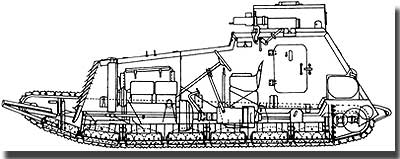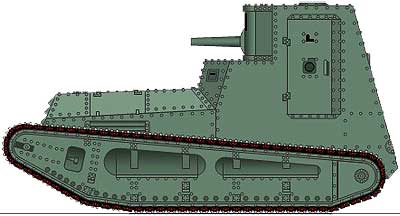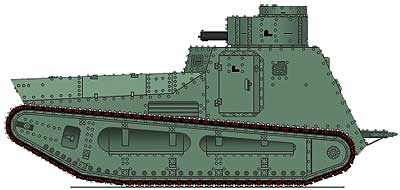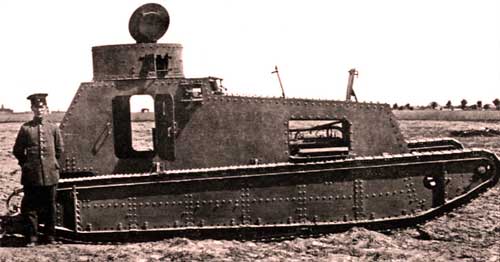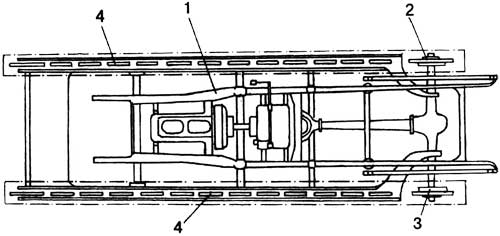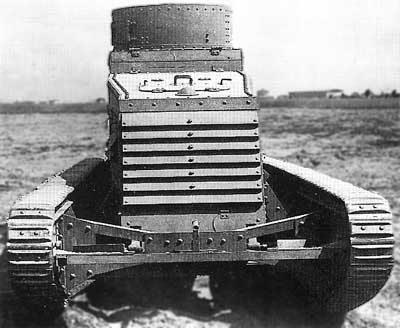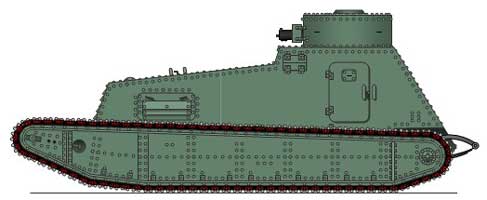
Light tank LK-I (Leichte Kampfwagen LK-I)
Light tank LK-I (Leichte Kampfwagen LK-I)
The use of an automobile chassis "inside" a caterpillar one was implied, installing the drive wheels of the caterpillar on their drive axles. Germany was probably the first to understand this advantage of light tanks - as the possibility of widespread use of automotive units.
You can enlarge the image of the layout of the light tank LK-I The project was presented in September 1917. After approval by the head of the Inspectorate of Automobile Troops, on December 29, 1917, it was decided to build light tanks. But the Headquarters of the High Command rejected this decision on 17.01.1918/1917/XNUMX, as it considered the armor of such tanks too weak. A little later it became known that the High Command itself was negotiating with Krupp about a light tank. The creation of a light tank under the leadership of Professor Rausenberger began at the Krupp firm in the spring of XNUMX. As a result, this work was still approved, and it was transferred to the jurisdiction of the Ministry of War. Experienced vehicles received the designation LK-I (light combat vehicle) and permission was given to build two copies. For reference. In literature, incl. from well-known authors, and on almost all sites, the following three images are referred to as LK-I. Is it so?
In the book “GERMAN TANKS IN WORLD WAR I” (authors: Wolfgang Schneider and Rainer Strasheim) there is a picture that has a more reliable caption:
"...Chapter II (machine-gun version)“. Machine-gun (English) - a machine gun. Let's try to understand and demonstrate:
Light combat vehicle LK-I (протот.)
Light combat vehicle LK-II (протот.), 57 мм
Light chariots LK-II, Tank w / 21 (Swede.)
Tank w / 21-29 (Swede.) Opening Wikipedia, we see: “Due to the defeat of Germany in the war, the LT II tank never entered service with the German army. However, the Swedish government found a way to acquire ten tanks that were stored in a factory in Germany in disassembled condition. Under the guise of agricultural equipment, the tanks were transported to Sweden and assembled there.” However, back to LK-I. Basic requirements for a light tank:
It was proposed to increase the angle of elevation of the inclined branch of the caterpillar to increase cross-country ability and efficiency when overcoming wire obstacles. The volume of the fighting compartment had to be sufficient for normal operation, and the boarding and disembarkation of the crew should be simple and quick. It was necessary to pay attention to the arrangement of viewing slots and hatches, fire safety, sealing the tank in case the enemy used flamethrowers, protecting the crew from splinters and lead splashes, as well as the availability of mechanisms for maintenance and repair and the possibility of a quick replacement of the engine, the presence of a caterpillar cleaning system from dirt.
The caterpillar chassis was assembled on a special frame. The undercarriage of each side was between two longitudinal parallel walls connected by transverse jumpers. Between them, undercarriages were suspended to the frame on helical coil springs. There were five carts with four road wheels each on board. Another cart was rigidly fastened in front - its rollers served as stops for the ascending branch of the caterpillar. The axle of the rear drive wheel was also rigidly fixed, which had a radius of 217 mm and 12 teeth. The guide wheel was raised above the bearing surface, and its axis was equipped with a screw mechanism for adjusting the tension of the tracks. The longitudinal profile of the caterpillar was calculated so that when driving on a hard road, the length of the supporting surface was 2.8 m, on soft ground it increased slightly, and when passing through the trenches it reached 5 m. The raised front part of the caterpillar protruded ahead of the hull. Thus, it was supposed to combine agility on hard ground with high maneuverability. The design of the caterpillar repeated the A7V, but in a smaller version. The shoe was 250 mm wide and 7 mm thick; rail width - 80 mm, rail opening - 27 mm, height - 115 mm, track pitch - 140 mm. The number of tracks in the chain increased to 74, which contributed to the increase in travel speed. The breaking resistance of the chain is 30 tons. The lower branch of the caterpillar was kept from the lateral displacement by the central flanges of the rollers and the sidewalls of the undercarriages, the upper one by the frame walls. Tank chassis diagram
1 - car frame with transmission and engine; 2, 3 - driving wheels; 4 - caterpillar mover Inside such a finished tracked chassis, a car frame with the main units was attached, but not rigidly, but on the remaining springs. Only the rear axle, which was used to drive the drive wheels, was rigidly connected to the side frames of the caterpillar track. Thus, the elastic suspension turned out to be two-stage - helical springs of the running bogies and semi-elliptical springs of the inner frame. Novelties in the design of the LK tank were protected by a number of special patents, such as patents No. 311169 and No. 311409 for the features of the caterpillar device. The engine and transmission of the base car were generally retained. The entire design of the tank was an armored car, as if placed in a caterpillar track. Such a scheme made it possible to obtain a completely solid structure with an elastic suspension and a sufficiently large ground clearance.
The result was a tank with a front engine, rear - transmission and fighting compartment. At first glance, the resemblance to the English medium tank Mk A Whippet, which appeared on the battlefield only in April 1918, was striking. The LK-I tank had a rotating turret, as did the Whippet prototype (Tritton's light tank). The latter was officially tested in England in March 1917. Perhaps German intelligence had some information about these tests. However, the similarity of the layout can also be explained by the choice of an automobile scheme as the base one, while machine-gun, well-developed turrets were used on armored vehicles by all warring parties. Moreover, in terms of their design, the LK tanks differed significantly from the Whippet: the control compartment was located behind the engine, with the driver's seat located along the axis of the vehicle, and behind it was the fighting compartment.
The armored body of straight sheets was assembled on a frame using riveting. The cylindrical riveted turret had an embrasure for mounting the MG.08 machine gun, covered from the sides by two outer shields like the turrets of armored vehicles. The machine gun mount was equipped with a screw lifting mechanism. In the roof of the tower there was a round hatch with a hinged lid, in the stern there was a small double hatch. Embarkation and disembarkation of the crew was carried out through two low doors located on the sides of the fighting compartment opposite each other. The driver's window was covered with a horizontal double-leaf lid, in the lower wing of which five viewing slots were cut. Hatches with hinged covers in the sides and roof of the engine compartment were used to service the engine. The ventilation grilles had blinds. Sea trials of the first prototype LK-I took place in March 1918. They were very successful, but it was decided to finalize the design - to strengthen armor protection, improve the chassis and adapt the tank for mass production. | ||||||

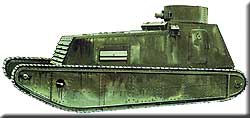 After they showed the layout of the German tank of the First World War A7V, the command proposed to create heavier “supertanks”. This task was entrusted to Josef Volmer, but he came to the conclusion that it is still more logical to build light machines that can be created faster and more. The conditions for the rapid creation and organization of production was the existence of automotive units and in large quantities. In the military department at that time there were over 1000 different vehicles with engines of 40-60 hp, which were recognized as unsuitable for use in the armed forces, those that were called “fuel and tire eaters”. But with the proper approach, it was possible to obtain groups of 50 or more units and, on this basis, create batches of light combat vehicles with a supply of units and assemblies.
After they showed the layout of the German tank of the First World War A7V, the command proposed to create heavier “supertanks”. This task was entrusted to Josef Volmer, but he came to the conclusion that it is still more logical to build light machines that can be created faster and more. The conditions for the rapid creation and organization of production was the existence of automotive units and in large quantities. In the military department at that time there were over 1000 different vehicles with engines of 40-60 hp, which were recognized as unsuitable for use in the armed forces, those that were called “fuel and tire eaters”. But with the proper approach, it was possible to obtain groups of 50 or more units and, on this basis, create batches of light combat vehicles with a supply of units and assemblies.